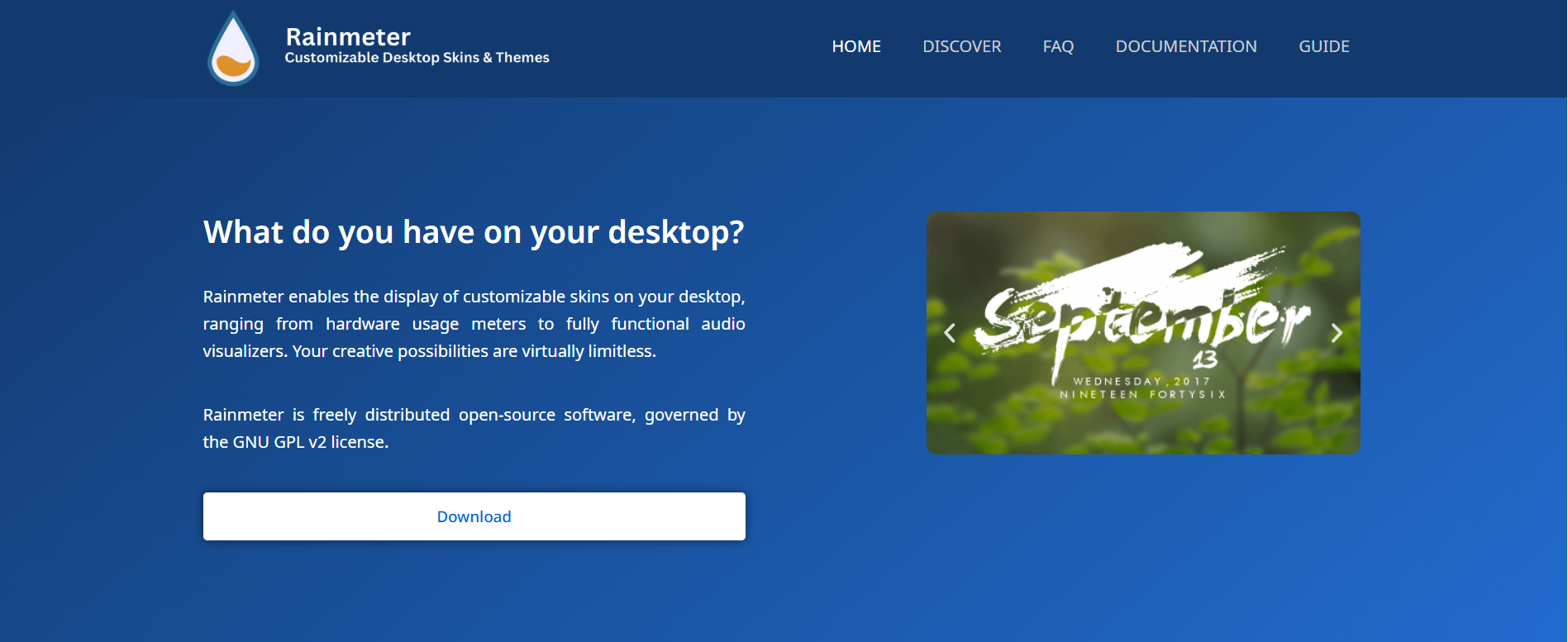Can Rainmeter Show Real-Time PC Stats?

Customizing your Windows desktop isn’t just about making it look cool — it’s also about making it functional. Enter Rainmeter, a powerful and lightweight desktop customization tool that’s been quietly dominating the scene for years. If you’re someone who wants to know exactly how your PC is performing at any given moment, you’ve probably wondered if Rainmeter can actually deliver real-time hardware stats.
The short answer? Yes, Rainmeter absolutely can display real-time PC performance data. But let’s break that down — because how it works, what you can track, and how it compares to traditional monitoring apps is where the real magic happens.
Power Behind the Platform
Unlike basic system widgets or bloated monitoring suites, Rainmeter runs entirely on skins — customizable, modular desktop elements that display data and visuals. These skins can track everything from CPU and GPU usage to RAM consumption, drive space, network speeds, and even temperature readings if you’ve got the right software back-end.
Rainmeter’s strength lies in its modular architecture. You’re not stuck with a one-size-fits-all layout. You pick and choose what stats matter, how they’re displayed, and even what they look like.
System Monitoring with Skins
Rainmeter skins are the heart of the program. They are text-based INI configuration files that run LUA scripts and call on various measures, including system-level APIs, to gather and present real-time data.
Here are just a few of the real-time stats you can track using Rainmeter:
- CPU usage per core
- GPU temperature and load
- RAM usage and swap space
- Disk usage by drive
- Fan speed and system temperatures
- Battery level and charge status
- Network upload/download speeds
- Processes and memory hogs
These are just the basics. With the right add-ons or plug-ins, Rainmeter can become a fully-fledged hardware monitor right on your desktop.
Plugins That Make It Happen
Rainmeter by itself is capable of reading system stats using built-in measures. But for advanced hardware monitoring, it leans on plugins — external modules that hook into software like HWiNFO, SpeedFan, or AIDA64.
Here’s how that works:
- HWiNFO plugin connects to the HWiNFO app to gather sensor-level data, including detailed temperature readings and fan speeds.
- SpeedFan plugin taps into the SpeedFan utility to show voltage, RPMs, and internal temps.
- CoreTemp plugin provides per-core temperature data from your CPU.
With these plugins, Rainmeter skins can visualize live readings as graphs, numbers, gauges, or even futuristic meters. Think of it like combining the power of a system diagnostic tool with the aesthetics of sci-fi dashboards.
Choosing the Right Skins
Not all Rainmeter skins are created equal. Some are purely cosmetic, while others are designed for performance tracking. If your focus is on real-time PC stats, check out skins in the following categories:
Hardware Monitors
Skins like Tech-A, Enigma, Gadgets, and illustro are known for combining style with functionality. These typically include CPU, RAM, disk, and network monitors.
Minimalist Meters
For clean, subtle setups, try skins like Simple Clean, LIM!T, or GlassHUD. These prioritize readability while keeping a light system footprint.
Advanced Stat Panels
If you want more depth, Flat, Omnimo, and Speed offer complex dashboards with detailed readouts across all your hardware components.
You can always combine elements from multiple skins to build a custom Rainmeter suite that matches your workflow and style.
Building a Custom Monitoring Layout
Creating your own Rainmeter setup for real-time PC stats isn’t as complicated as it sounds. Here’s a quick walkthrough:
- Install Rainmeter – Grab the latest version from the official site.
- Find Your Skins – Search on DeviantArt, GitHub, or Rainmeter forums for stat-focused skins.
- Install the Required Plugins – If your skin needs HWiNFO, install it and activate the shared memory option.
- Load Skins – Open Rainmeter, navigate to your installed skin folder, and load the modules you need.
- Position and Resize – Arrange the modules on your desktop however you like.
- Edit INI Files (Optional) – Want a different font, size, color, or update interval? Right-click the skin, hit “Edit skin,” and tweak the code.
This workflow gives you the power to transform your static desktop into a live performance dashboard.
Performance and Resource Use
One common concern with real-time monitors is system overhead. Traditional apps like MSI Afterburner or NZXT CAM can eat up a noticeable amount of RAM and CPU. So, what about Rainmeter?
Good news: Rainmeter is incredibly lightweight. Most skins consume only a few megabytes of RAM. Even complex setups rarely exceed 20-30MB. That means you can keep all your real-time widgets active without dragging down your system’s performance — especially critical during gaming, streaming, or rendering sessions.
Rainmeter also supports update intervals, letting you define how often each widget pulls new data. Want stats updated every second? You can. Prefer a 10-second refresh to save resources? That’s just a line of code away.
Visualizing the Data
Presentation is everything, especially when it comes to live stats. Rainmeter excels here with:
- Bar meters
- Circular gauges
- Analog dials
- Animated graphs
- Numeric values with units
- Color changes based on thresholds
You can even set alerts — for example, turning a temperature gauge red if the CPU hits 90°C. This makes Rainmeter both stylish and practical.
Gaming and Streaming Use Cases
Gamers, streamers, and content creators love Rainmeter because it provides essential diagnostics at a glance — no need to tab out or open overlays.
For streamers using dual-monitor setups, placing Rainmeter skins on the secondary display lets them monitor:
- CPU load while encoding
- System temperature under load
- RAM consumption across apps
- Upload speeds during livestreams
It’s also possible to hide or minimize the widgets with hotkeys, making them non-intrusive during gameplay. In a world where every frame counts, this kind of utility without overhead is a major win.
Alternatives vs. Rainmeter
You might be wondering: why not just use dedicated system monitoring tools?
Here’s how Rainmeter compares to some alternatives:
| Tool | Real-Time Stats | Custom Skins | Resource Use | Visuals |
| Rainmeter | ✅ Yes | ✅ Fully | 🟢 Low | 🟢 Highly customizable |
| HWMonitor | ✅ Yes | ❌ None | 🟡 Moderate | 🔴 Basic interface |
| NZXT CAM | ✅ Yes | ❌ Limited | 🟡 Moderate | 🟡 Polished, but not customizable |
| MSI Afterburner | ✅ Yes | ❌ None | 🟡 Moderate | 🔴 Utility-focused |
| Sidebar Diagnostics | ✅ Yes | ❌ Minimal | 🟢 Light | 🟡 Simple but clean |
Rainmeter stands alone in the ability to combine performance stats with full control over appearance, layout, and behavior.
Community Support and Resources
Another huge plus is Rainmeter’s active and creative community. Need help integrating a plugin? Want to tweak a visual element? Looking for feedback on a custom design?
You’ll find it all in:
- Rainmeter subreddit
- Rainmeter forums and Discord servers
- GitHub repositories with open-source skins
- YouTube tutorials on building and coding skins
This open ecosystem ensures Rainmeter continues evolving — not as a product, but as a community-driven customization platform.
Final Thoughts
Rainmeter isn’t just a pretty face for your desktop — it’s a powerful and flexible way to keep an eye on what your computer is doing, in real time. Whether you’re a gamer, power user, or just a stats junkie, Rainmeter offers the freedom to monitor what matters without compromise.



